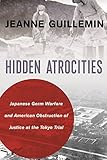Hidden Atrocities : Japanese Germ Warfare and American Obstruction of Justice at the Tokyo Trial / Jeanne Guillemin.
Material type: TextSeries: A Nancy Bernkopf Tucker and Warren I. Cohen Book on American-East Asian RelationsPublisher: New York, NY : Columbia University Press, [2018]Copyright date: ©2017Description: 1 online resourceContent type:
TextSeries: A Nancy Bernkopf Tucker and Warren I. Cohen Book on American-East Asian RelationsPublisher: New York, NY : Columbia University Press, [2018]Copyright date: ©2017Description: 1 online resourceContent type: - 9780231183529
- 9780231544986
- 341.6/90268 23
- KZ1181 .G85 2017
- KZ1181 .G85 2017eb
- online - DeGruyter
- Issued also in print.
| Item type | Current library | Call number | URL | Status | Notes | Barcode | |
|---|---|---|---|---|---|---|---|
 eBook
eBook
|
Biblioteca "Angelicum" Pont. Univ. S.Tommaso d'Aquino Nuvola online | online - DeGruyter (Browse shelf(Opens below)) | Online access | Not for loan (Accesso limitato) | Accesso per gli utenti autorizzati / Access for authorized users | (dgr)9780231544986 |
Browsing Biblioteca "Angelicum" Pont. Univ. S.Tommaso d'Aquino shelves, Shelving location: Nuvola online Close shelf browser (Hides shelf browser)

|

|

|

|

|

|

|
||
| online - DeGruyter The Shahnameh : The Persian Epic as World Literature / | online - DeGruyter Why Only Art Can Save Us : Aesthetics and the Absence of Emergency / | online - DeGruyter Found Life : Poems, Stories, Comics, a Play, and an Interview / | online - DeGruyter Hidden Atrocities : Japanese Germ Warfare and American Obstruction of Justice at the Tokyo Trial / | online - DeGruyter Sovereign Wealth Funds in Resource Economies : Institutional and Fiscal Foundations / | online - DeGruyter The Stigma Effect : Unintended Consequences of Mental Health Campaigns / | online - DeGruyter Local Politics in Jordan and Morocco : Strategies of Centralization and Decentralization / |
Frontmatter -- CONTENTS -- Prologue: General Ishii and Germ Warfare -- Introduction: Lasting Peace and the Protection of Civilians -- 1. MacArthur in Japan: "Punish the War Criminals" -- 2. Spoils of War: Secret Japanese Biological Science -- 3. International Prosecution Section: Toward the "Swift and Simple Trial" -- 4. The Investigation for Evidence in China -- 5. The Best Witnesses -- 6. Tokyo: The Rush to Trial -- 7. The Trial Begins -- 8. The Atrocities -- 9. The Soviet Division Versus US Military Intelligence -- 10. National Security Versus Medical Ethics -- 11. Open and Closed Trials -- Epilogue: The Fallout -- Acknowledgments -- Source Notes -- ACRONYMS -- Principal Characters -- Notes -- Index
restricted access online access with authorization star
http://purl.org/coar/access_right/c_16ec
In the aftermath of World War II, the Allied intent to bring Axis crimes to light led to both the Nuremberg trials and their counterpart in Tokyo, the International Military Tribunal of the Far East. Yet the Tokyo Trial failed to prosecute imperial Japanese leaders for the worst of war crimes: inhumane medical experimentation, including vivisection and open-air pathogen and chemical tests, which rivaled Nazi atrocities, as well as mass attacks using plague, anthrax, and cholera that killed thousands of Chinese civilians. In Hidden Atrocities, Jeanne Guillemin goes behind the scenes at the trial to reveal the American obstruction that denied justice to Japan's victims.Responsibility for Japan's secret germ-warfare program, organized as Unit 731 in Harbin, China, extended to top government leaders and many respected scientists, all of whom escaped indictment. Instead, motivated by early Cold War tensions, U.S. military intelligence in Tokyo insinuated itself into the Tokyo Trial by blocking prosecution access to key witnesses and then classifying incriminating documents. Washington decision makers, supported by the American occupation leader, General Douglas MacArthur, sought to acquire Japan's biological-warfare expertise to gain an advantage over the Soviet Union, suspected of developing both biological and nuclear weapons. Ultimately, U.S. national-security goals left the victims of Unit 731 without vindication. Decades later, evidence of the Unit 731 atrocities still troubles relations between China and Japan. Guillemin's vivid account of the cover-up at the Tokyo Trial shows how without guarantees of transparency, power politics can jeopardize international justice, with persistent consequences.
Issued also in print.
Mode of access: Internet via World Wide Web.
In English.
Description based on online resource; title from PDF title page (publisher's Web site, viewed 02. Mrz 2022)


